Schengen Visa Application Process
On this page, we'll walk you through each step in the Schengen visa application process. We go into much more detail here than the overview provided on Schengen Visa: Everything You Need to Know.
1. Determine Whether You Need a Schengen Visa
2. Apply for Your Passport
3. Figure Out Where to Apply
4. Determine Whether to Apply in Person
5. Plan the Timing of Your Application
6. Schedule Schengen Visa Application Appointment
7. Plan the Specifics of Your Trip
8. Purchase Required Travel Medical Insurance
9. Collect Trip-Planning Documents
10. Complete Schengen Visa Application Documents
11. Go to Your Visa Application Appointment
12. Pay the Schengen Visa Application Fee
Explore each visa application step in detail by clicking on the links above, or just scroll through the steps below.
1. Determine Whether or Not You Need a Schengen Visa for Your Trip to Europe
Citizens of some countries are required to possess a Schengen visa, while citizens of other countries are exempt from the Schengen visa requirement. Click here to see the list of required and exempt countries and learn whether or not you need a Schengen visa for your travels.
PRO TIP: If your trip entails visits to multiple countries, check whether they’re all included in the Schengen Area. If your travel plans require you to leave the Schengen Area and re-enter it later on, you may be eligible for a double or multiple-entry visa. Keep in mind that you may need to apply for an individual visa in each of the non-Schengen countries you will be visiting.
To learn more about multiple-entry visas and discover whether or not you're eligible, check out Who Needs a Schengen Visa?
2. Apply for Your Passport
In addition to a Schengen visa, you will need a valid passport in order to enter the countries in the Schengen Area.
If you don’t already have a passport, you will need to apply for one through your country of citizenship. Routine processing typically takes 4-6 weeks, but wait times peak in spring and summer (and around holidays). Applying at least 3 months early can save you some additional stress.
If you already have a passport, ensure it meets the following Schengen visa requirements from the European Commission:
-
Must be valid for 3 months after the date you plan to leave the Schengen Area (if traveling on a multi-entry visa, must be valid for 3 months after the last day of your final visit to the Schengen Area)
-
Must contain at least 2 blank pages
3. Figure Out Where You Are Required to Apply for Your Visa
According to general rules from the European Commission, you must apply for a Schengen visa at the embassy or consulate of your main Schengen destination. Your main Schengen destination is the Schengen country where you plan to spend the most days.
If your trip entails visits to multiple Schengen countries and you plan to spend the same number of days in each, you must apply at the embassy or consulate of the Schengen country you will enter first.
You are required to apply at the embassy or consulate in whose jurisdiction you legally reside. If no embassy or consulate exists for your Schengen destination within your country of residence, then another embassy or consulate likely represents it. You will need to go to that representative embassy or consulate instead.
PRO TIP: To see a list of Schengen states’ consular representation within non-Schengen countries, visit the European Commission’s “Where and How to Apply” page. Click the link that says “list of consular presence and representation” to download the Excel sheet. Then click the “represent. and ESP in 3rd countries” tab at the bottom of the page.
To view a list of honorary consulates authorized to collect Schengen visa applications, click the “honorary consuls” tab instead.
4. Determine Whether or Not You Are Required to Apply in Person
First-time applicants who are not registered in Europe’s Visa Information System (VIS) will be required to submit an application in person. Fingerprints will be collected at this time.
If you are a VIS-registered traveler and your fingerprints were last collected within the 59 months prior to your trip’s start date, you may be permitted to:
-
Submit your application to the designated location by courier or
-
Designate a third party to submit your application.
However, visa requirements can vary slightly by country. So before taking the above actions, contact your designated consulate or review its application guidelines to see if this applies to you.
5. Consider the Best Time to Submit Your Schengen Visa Application
According to the European Commission, you must submit your Schengen visa application at least 15 days prior to the start date of your trip. You cannot submit your application any earlier than 3 months before you start your trip.
Ideally, you should submit your application 30-60 days in advance in case the consulate requests additional information or needs more time to examine your application.
6. Schedule Your Schengen Visa Application Appointment
To lodge your Schengen visa application, you will need to schedule an appointment with your designated embassy or consulate ahead of time. You may be required to do this online or via phone.
To Schedule Online:
Try searching “schedule appointment for [destination] Schengen visa in [city of residence].” For example, a legal resident of New Delhi planning to travel to Germany would search “schedule appointment for Germany Schengen visa in New Delhi.” Then click the relevant link and follow any instructions specifying how to make an appointment.
Many embassies and consulates provide scheduling means through a visa management system called VFS Global. In fact, the first result from the above search query leads to www.vfs-germany.co.in/newdelhi_northindia – a VFS Global page containing both a phone number and a link to schedule an appointment online.

If you are able to schedule an appointment via VFS Global, the appointment scheduling link will take you to the VFS log-in page. Click the “New User?” link to register.
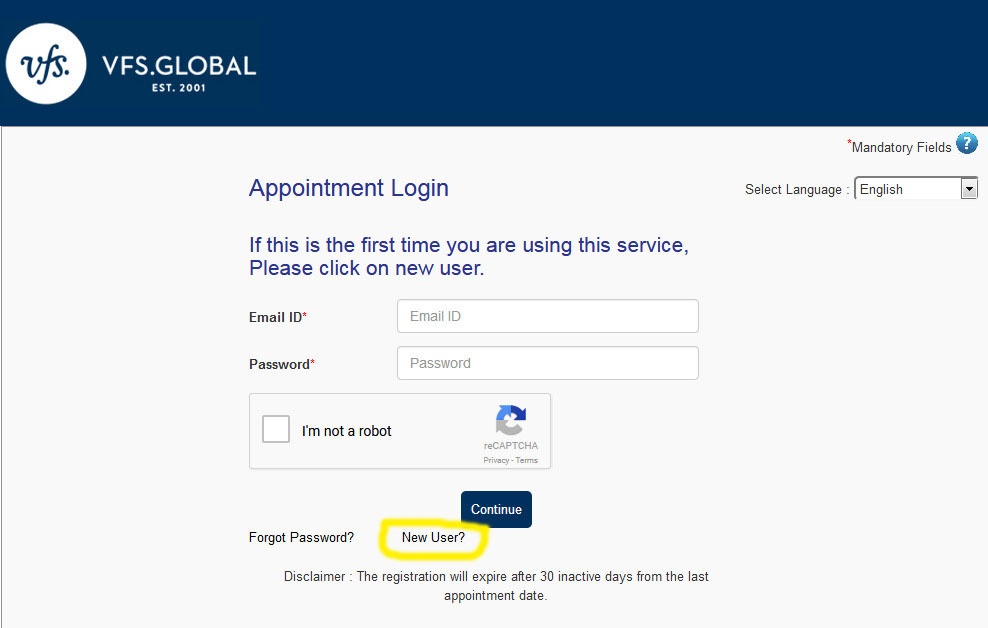
Then fill out the “New User Registration Form” and click “Submit.”
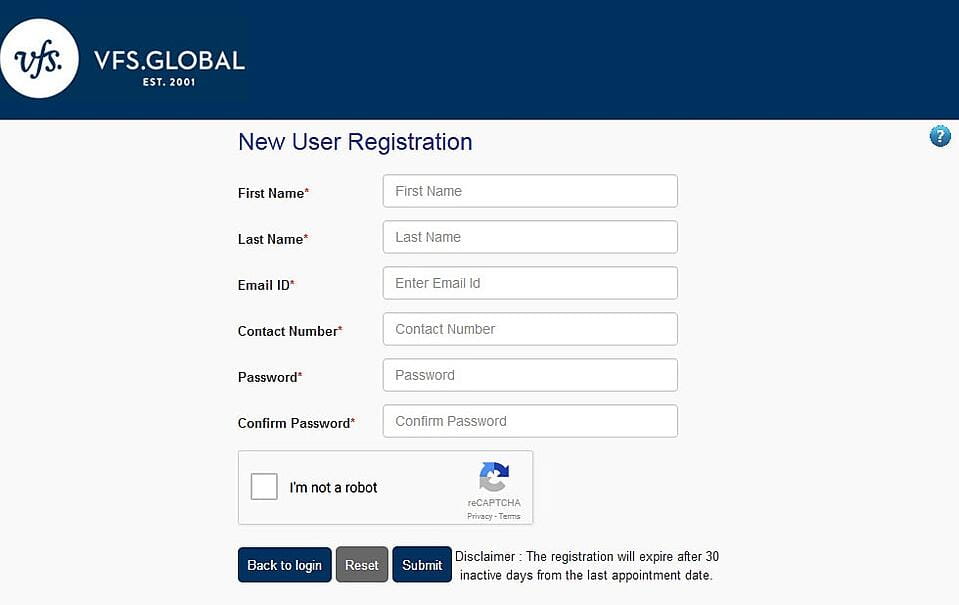
After you submit the form, you will get an email from VFS which contains the link you need to activate your account. Once you click the activation link, you will return to the log-in page.
This time, use your email address and password to log in. Then select “Schedule Appointment” on the left-hand sidebar and fill in the information under “Select Centre.”
You will choose your main Schengen destination country, the country in which you legally reside, the consulate serving the jurisdiction where legally reside, and your visa category. Then click “Continue.”
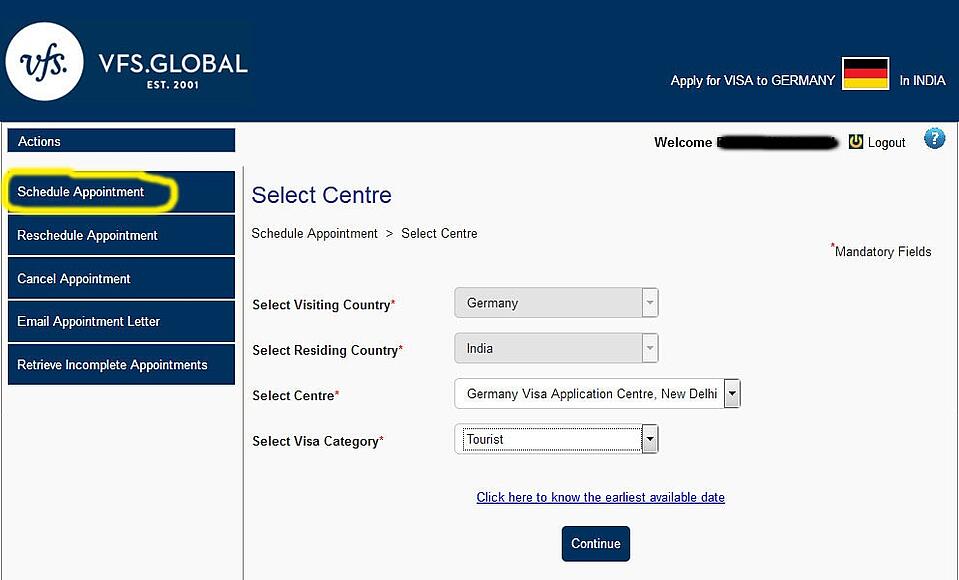
On the next page, choose the “Add Applicant” button for each applicant.
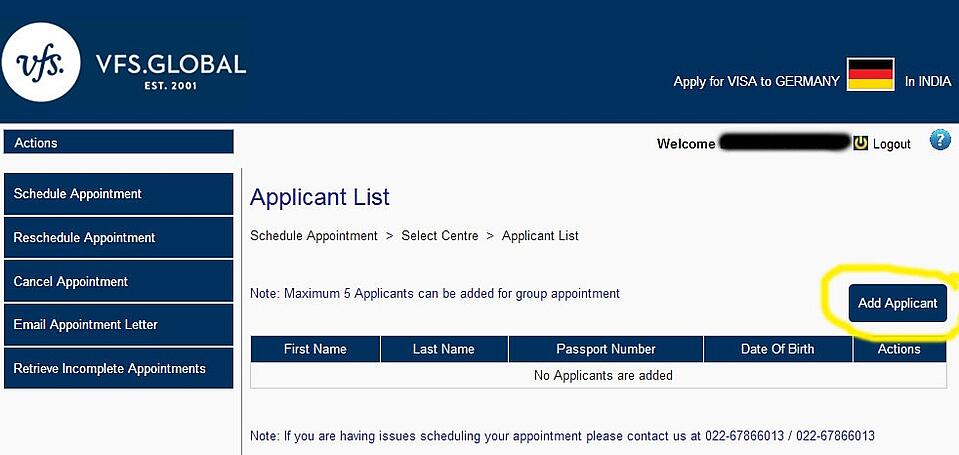
Then fill out the required information.
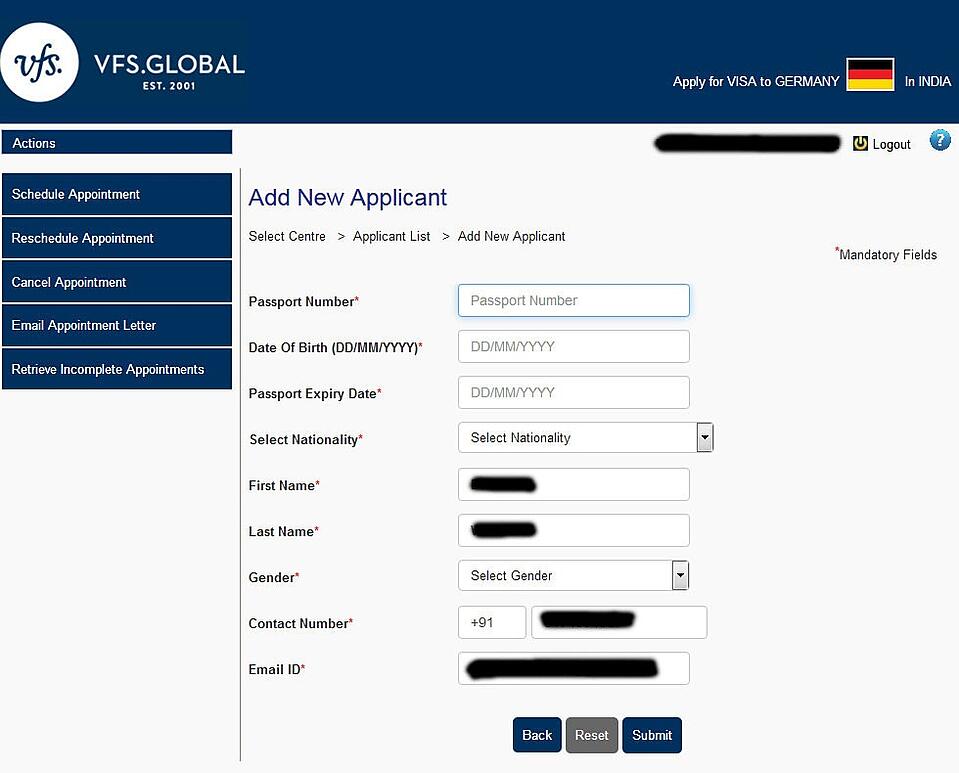
Once you click “Submit,” follow the instructions to select the date and time of your Schengen visa application appointment. If you end up needing to reschedule or cancel your appointment, you can do so by choosing the appropriate link from the left-hand sidebar and following the instructions.
To Schedule by Phone:
EmbassyPages.com can help you find contact information for your designated embassy or consulate. On the site’s home page, select your main Schengen destination.
REMEMBER: Your main Schengen destination is the Schengen country where you plan to spend the most days. If your trip entails visits to multiple Schengen countries and you plan to spend the same number of days in each, your main Schengen destination is the Schengen country you will enter first.
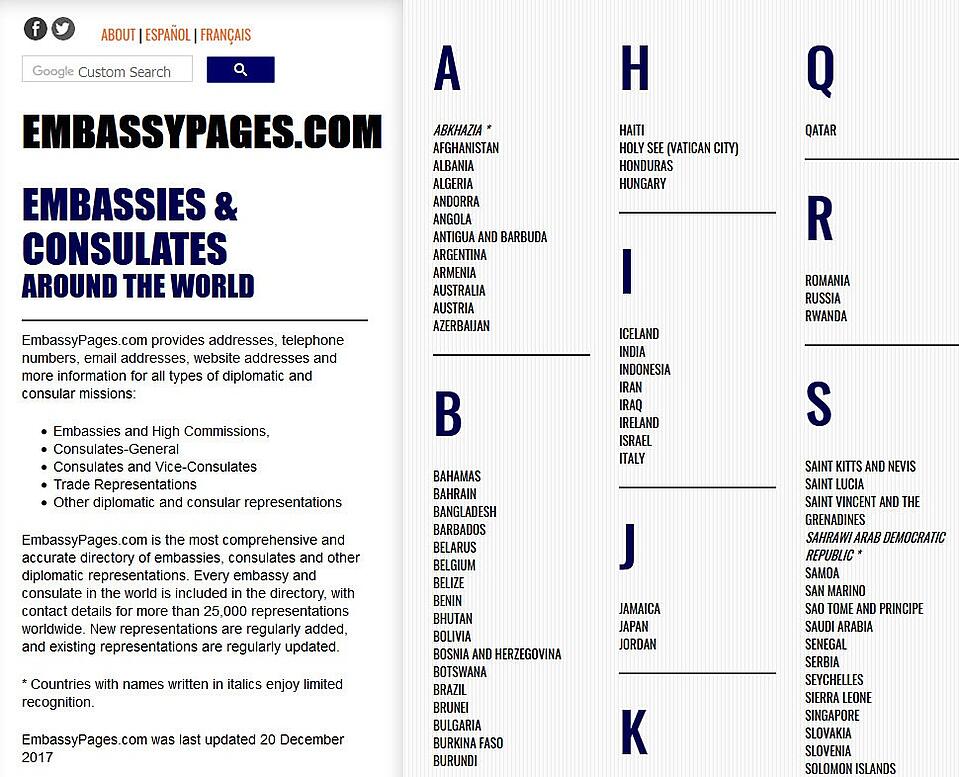
(Following the example above, we selected Germany.) Then, from the right-hand list, select your country of residence. If there are multiple embassies or consulates listed for your country of residence, select the one serving the area where you live.

(Keeping with our example, we selected “India – New Delhi.”) You can then use the phone number listed for your designated embassy or consulate to contact its authorities. They can help you schedule an appointment or direct you to the webpage where you can make an appointment online.
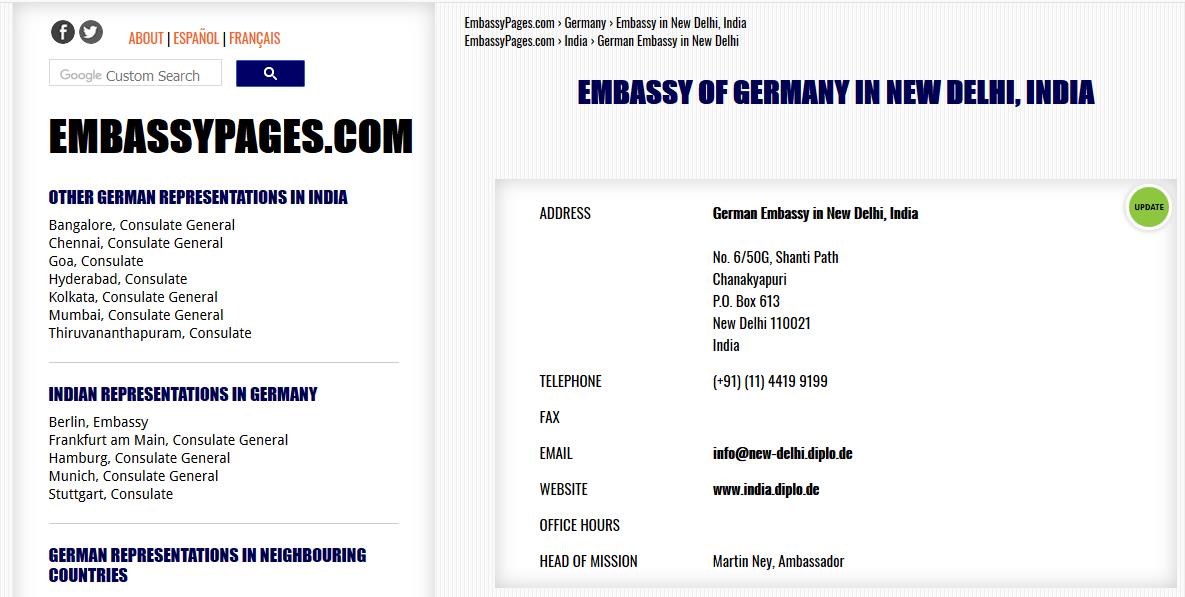
7. Plan Your Trip and Keep Copies of All Documents Related to Your Travel Plans
At this point, you should begin planning your trip. Keep copies of all your bookings and confirmations. You will need these documents to show proof of your travel plans when you apply for your visa.
You do not need to purchase round-trip flight tickets prior to your visa appointment. There’s always a chance your visa could be denied. However, you may need to show your original air ticket when your visa is collected. You will need to show a round-trip reservation or flight schedule with flight numbers, however.
Not sure how to get a flight schedule without booking a flight? Check out 14 Ways to Get a Travel Itinerary for a Visa Application.
You will also need a reservation or confirmation of accommodations. Book a hotel that offers free cancellations in case your visa application is denied. You may also use an invitation letter if you are staying with a host.
If you plan any activities, print copies of your reservations for each activity.
8. Purchase Travel Medical Insurance that Meets Schengen Visa Insurance Requirements
As a short-stay visa applicant, you are required to show evidence of travel medical insurance that is valid in all Schengen countries.
You’re free to choose your own insurance as long as it meets the following Visa Code requirements:
-
Minimum coverage of 30,000 Euros (about USD $33,819)
-
Coverage for repatriation expenses
-
Coverage for emergency medical treatment
-
Coverage for expenses incurred as a result of your death
-
Coverage for the entire period of your stay
-
Valid in all Schengen Area countries
One option for health insurance that meets Schengen visa requirements is Atlas Travel insurance. This budget-friendly plan offers coverage choices of up to $2,000,000 for unexpected injury or illness, up to $1,000,000 for a covered emergency medical evacuation, and AD&D coverage.
Atlas Travel utilizes a worldwide provider-referral network, with doctors and hospitals in all Schengen countries. Plus, your Atlas Travel plan will provide you with access to a visa letter you can use as proof of valid health insurance.
Price your plan now or learn how Atlas Travel meets Schengen visa insurance requirements.
9. Gather Required Documents and Supporting Documents
Before you head to your Schengen visa application appointment, make sure you’ve gathered all the documents you need in order to apply for a visa.
Required documents include:
-
Completed and signed visa application form (one for each person listed in your travel documents – see step #10 for details)
-
Passport (see step #2 for passport requirements)
-
Two recent, color photographs that meet ICAO requirements
-
One-page document stating the dates and scope of travel medical insurance that meets Schengen visa requirements
You will also be required to submit documents which support:
-
The purpose of your travel,
-
Proof of accommodation,
-
Your intentions to return to your country of residence at the end of your trip, and
-
How you will pay for your trip expenses
See examples of accepted documents for each category.
10. Download the Application for a Schengen Visa and Fill It Out
The European Commission provides the Schengen visa application form here. Before you get started, make sure you have the following information on hand – you’ll need it in order to complete your application.
Have these documents on hand:
-
Passport info – Passport type, number, issue date, and issuing authority
-
Job info – Occupation and employer contact info
-
Destination info – Name of main destination, name of Schengen state you will enter first, number of entries requested (single, double, or multiple), and intended duration of stay or transit
-
Schengen visa info – Previous Schengen visas held and intended arrival/departure dates
-
Host or lodging info – Contact info for host, inviting company, or hotel/accommodations
-
Travel cost – How you are paying for your trip
Next step: fill out the form! Be sure to fill in the boxes legibly and completely to ensure your application is processed without delay.
Follow these Schengen visa application form tips:
-
Fill out a separate application form for each traveler.
-
Use an original form, a legible photocopy of an original form, or a downloaded copy.
-
Fill in the application form electronically or by hand.
-
If you are filling in the form by hand, write legibly using a black ballpoint pen.
-
Use ROMAN CAPITAL LETTERS.
-
Complete all sections except those marked “FOR OFFICIAL USE ONLY.”
-
Fields marked with * should not be filled in by family members of EU, EEA, or CH citizens. Family members of EU, EEA, or CH citizens must present documents that prove the nature of your relationship.
-
Fill in your personal identification information exactly as it is stated in your travel documents.
-
For dates, follow the DD-MM-YYYY format. For example, December 1, 1980, should be written as “01-12-1980.”
-
For phone numbers, include the country code. Example: (+65) 123-4567
-
Keep all answers within the designated boxes. If you need more room, you may enclose a separate sheet of paper with your application form.
-
When a question offers multiple answers, mark boxes which apply with an “X.”
-
If you do not know the requested information, leave the answer box blank. If it does not apply, write “N/A.”
-
Applications for individuals under 18 must be signed by a parent or guardian.
-
Be 100% truthful. Failure to do so can result in your application being denied.
-
Be sure to provide current contact information in case the consulate needs to reach you.
11. Lodge Your Application at the Appropriate Consulate
On the day of your visa appointment, plan to arrive at the consulate 30 minutes early. In nearly all situations, you must go into your visa appointment by yourself.
The only exceptions to this rule are as follows:
-
You are a parent accompanying a minor
-
You are accompanying an adult visa applicant with special needs
-
You are the spouse or adult child of a visa applicant who is 80 years or older
In all three situations, you must submit a request at least 24 hours prior to the interview.
Be sure to bring all required documents listed in step #9 as well as relevant supporting documents. If you are required to pay a visa application fee, bring a valid form of payment to cover the cost (see step #12 for details).
If you are not currently registered in Europe’s Visa Information System (VIS) – or if you were entered in the system over 59 months prior to your date of application – then your fingerprints will be collected at this time.
12. Pay the Visa Application Fee (and Keep Proof of Payment)
When you submit your application, you will be required to pay a visa fee. In general, application fees for all types of transit and short-stay visas are as follows:
-
Individuals 13 Years and Older: EUR 60 (about USD $70.70)
-
Children 6-12 Years Old: EUR 35 (about USD $41.25)
-
Children 5 Years and Younger: No Fee
If you are a national of a country which has concluded Visa Facilitation Agreements with the EU, the application fee is EUR 35 (about USD $41.25).
If you are applying for a national long-stay visa, contact the issuing consulate for visa fee information. Be sure to keep proof of payment.
Application Fee Exemptions
The application fee is waived if you fall into one of these categories:
-
Students and teachers who are visiting the Schengen Area for the purpose of studying or partaking in educational training
-
Researchers from non-Schengen countries traveling to the Schengen Area to perform scientific research
-
Representatives of non-profit organizations who are 25 years old or younger and participating in events organized by non-profits
-
Family members of EU/EEA citizens who fall under Directive 2004/38
NOTE: Individual Schengen states may offer additional visa fee waivers, so check with the consulate where you are required to apply. No refunds are provided for withdrawn or denied applications.
Check out our Schengen Visa Application Guide!
KHE2FFFYH6SP-152-1747
WorldTrips international travel medical insurance products are underwritten by Lloyd's. WorldTrips is a service company and a member of the Tokio Marine HCC group of companies. WorldTrips has authority to enter into contracts of insurance on behalf of the Lloyd's underwriting members of Lloyd's Syndicate 4141, which is managed by HCC Underwriting Agency, Ltd.
